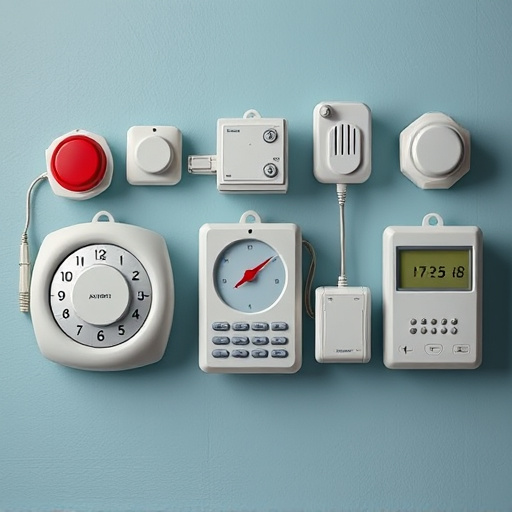Discrete wearable security alarm systems enhance personal safety in large buildings and public spaces, offering a reliable distress signal with loud sounds and flashing lights. The key advantage is the Personal Alarm Range in Buildings, allowing users to request help conveniently from any location within structured environments. These systems, equipped with customizable sensitivity levels, adapt to diverse settings while detecting falls, sudden movements, or distress signals through sensors, accelerometers, and gyroscopes. Regular maintenance, strategic placement, and user training are essential for optimal effectiveness.
“Discover the power of discrete wearable security alarm systems, a revolutionary personal safety solution. This comprehensive guide explores how these innovative devices enhance security, especially within buildings. From understanding their unique benefits and components to implementing effective maintenance strategies, we delve into the key aspects.
Personal alarm ranges in buildings have never been more crucial, offering discreet yet powerful protection. Learn how wearable alarms can transform spaces, ensuring peace of mind for individuals while promoting a safer environment.”
- Understanding Discrete Wearable Security Alarm Systems
- Benefits of Personal Alarm Range in Buildings
- Components and Functionality of Wearable Alarms
- Implementing and Maintaining Secure Wearable Alarm Systems
Understanding Discrete Wearable Security Alarm Systems
Discrete wearable security alarm systems are innovative personal safety devices designed for individuals seeking enhanced protection, especially in large buildings or public spaces. These compact and discreet alarms offer a unique approach to personal security by allowing users to carry a potential deterrent at all times. The primary function is to provide a reliable means of alerting others in case of distress or an unexpected emergency.
These wearable systems typically consist of a small, lightweight device that can be attached to clothing or stored in a pocket. When activated, the alarm emits a loud and distinct sound, often with flashing lights, to attract attention and deter potential threats. The Personal Alarm Range in Buildings is a significant consideration, as these devices ensure individuals have a convenient way to signal for help from a distance, making them ideal for scenarios where immediate assistance is required.
Benefits of Personal Alarm Range in Buildings
In the context of wearable security alarm systems, understanding the Personal Alarm Range in Buildings is paramount for enhancing safety measures. One of the significant advantages is its ability to provide a comprehensive coverage area within structured environments such as offices, residential complexes, or public spaces. This means that individuals wearing these discrete alarms can trigger an alert not only in open areas but also within corners, corridors, and enclosed spaces, ensuring no hidden threats go undetected.
Furthermore, the Personal Alarm Range allows for precise control and customization of sensitivity levels, catering to diverse environments and individual needs. In crowded settings, a slightly lower range setting can avoid false alarms while still ensuring personal safety. Conversely, in spacious areas or outdoor scenarios, extending the alarm range can provide added protection against potential dangers lurking at a distance.
Components and Functionality of Wearable Alarms
Wearable alarm systems are a discrete yet powerful personal security solution, designed to offer protection within various environments, including buildings. These innovative devices typically consist of several key components that work in harmony to ensure effectiveness and user convenience. A core element is the wearable device itself, often in the form of a bracelet or pendant, which houses sensors and a small alarm. This compact unit can detect specific triggers like falls, sudden movements, or personal distress signals, thanks to integrated accelerometers and gyroscopes.
Upon detecting an incident, the wearable sends a signal to a central control unit, either through Bluetooth or cellular networks. This unit processes the data and can initiate various responses, such as triggering a loud alarm, sending alerts to pre-registered contacts, or even contacting emergency services directly. The system’s functionality extends further with additional features like automatic fall detection, which can be crucial in scenarios where individuals might be unable to activate the alarm manually. These personal alarm range devices are ideal for vulnerable populations, offering them peace of mind and a sense of security while moving around in buildings or other public spaces.
Implementing and Maintaining Secure Wearable Alarm Systems
Implementing secure wearable alarm systems requires careful consideration of personal alarm range in buildings and overall system integration. These discrete devices are designed to offer users added protection while ensuring minimal disruption to daily activities. When deploying such systems, it’s crucial to assess the coverage area based on the specific building layout, considering factors like width, height, and potential obstacles. This ensures that alarms trigger within an optimal range for effective response.
Regular maintenance is another key aspect for keeping these systems secure and reliable. Batteries should be checked and replaced promptly, while software updates can enhance performance and security protocols. Additionally, users must receive adequate training on system functionality and emergency procedures to maximize their effectiveness. This holistic approach to implementation and maintenance ensures that wearable alarm systems provide the intended level of safety and peace of mind.
Discrete wearable security alarm systems offer a revolutionary approach to personal safety, particularly within buildings. By leveraging advanced technology, these systems provide individuals with an increased sense of security and peace of mind. The benefits are clear: enhanced protection, discreet operation, and improved response times in emergency situations. When implemented correctly, with a focus on reliable components and ongoing maintenance, wearable alarms can significantly boost the safety of occupants in various settings, especially within large or complex buildings where traditional alarm systems may fall short.
